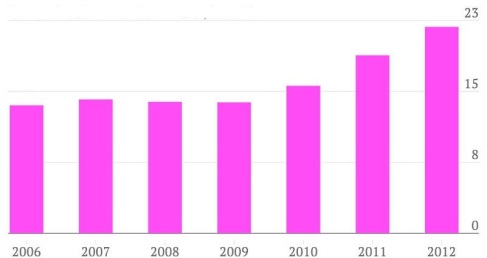Tsunami: It’s generally caused by volcanoes or earthquakes. We can assume them as a powerful earthquakes which occur in oceans,lakes or seas. The word ”tsunami” comes from Japanese and it means ”harbor wave” but after the deadliest disaster hit Asian countries (Thailand,Indonesia,Malaysia,Sri Lanka,India,Maldives), everyone learned what tsunami is.
The disaster happened in December 2004, more than 240,000 people died and a large number of foreign tourists who were travelling to the Far East, missed, including Americans,Swedes,Swiss,Frenchs,Italians,Britishs and people from other thirty countries. As Karan and Subbiah (2011) pointed out:
”The waves struck tourist resorts from Phuket in Thailand to Bentos in Sri Lanka at the peak of the tourist and Christmas holiday season”.
Tourism is vital for developing countries, as it provides more opportunity to increase their tourism revenues. Also, specially Thailand,Sri Lanka and Maldives are popular destinations for long-haul holiday who are looking for exotic holiday with different cuisines and cultures. As it can be seen in the Figure 1. that, international arrivals to Thailand from 2006 to 2012 significantly increased (exception 2008) and reached 23 million arrivals. The famous travel guide book Lonely Planet (2012) recommend Thailand as a place of traveller’s paradise where it’s easy and cheap to have a dream holiday.
Figure 1. International Tourist Arrivals to Thailand between 2006-2012
Source: WordPress (2013)
The United Nations (2008) reported the Indian Ocean Tsunami of 2004’s impacts in Thailand, as the worst disaster ever strike Thailand and caused serious impacts on tourism,environment and economy. According to this information, we need to focus on arrivals after the Thailand hit by a tsunami. As the figure illustrates, how Thailand’s tourism dramatically decreased by -88.86 %,after the tsunami.
Figure 2.International Passenger Movements at Phuket Airport After Tsunami
Source: Thailand Tourism Review (2005)
After this natural disaster,of course,after a long term recovery and rebuilding,they recognised that they need to cope with tsunamis anyway. As a result, ”Thailand government set aside $112 million for immediate tsunami relief, 76 per cent of which was allocated to emergency relief and mitigation measures in the six provinces.Around 14 per cent of the relief budget went to projects for reviving the tourism industry in the Andaman areas…” (Nidhiprabha,2007). Also Salvano Briceno (2005),who is the director of the Inter-agency Secretaritat of the International Strategy for Disaster Reduction, clearly pointed out that countries in the Indian Ocean need to develop a regional early warning systems for tsunamis. On the other hand,besides the government,non-govermental organisations and private organizations were also focused on reconstruction projects to help Thai people. For example: the United Nations Children’s Fund (UNICEF) gave crucial support to fully reopen schools,the Asia Foundation gave free legal aid program to survivors who lost their houses..etc.
”As for the future, I am sure the lessons from the tsunami will stay with me forever. Not one day has gone by where I have not somehow been reminded of the traumatic and overwhelming events of one year ago. I have not been able to answer the question as to why I survived when over 223,000 people did not, inlcuding the fact that 80% of Thailand’s tsunami casualties occured in Khao Lak” as John Thompson-Khao Lak Tsunami Survivor says, the lessons from the tsunami will be remembered forever.
Image 1. Walking through the Rubble
Source: photo by John Thompson (2004)
Image 2. Massive Tsunami Waves in Thailand,2004
Source: Blogspot (2010)
References
Burke,A. (2012) Thailand’s Islands and Beaches, Lonely Planet Publications, Australia.
Karan, P.P. and Subbiah, P.S. (ed.) (2011) The Indian Ocean Tsunami:The Global Response to a Natural Disaster, The University Press of Kentucky, United States.
Nidhiprabha, B. (2007) Adjustment and Recovery in Thailand Two Years after the Tsunami, Asian Development Bank Institute Discussion Paper No.72,Tokyo.
Pike, S. (2008) Destination Marketing: an integrated marketing communication approach, Routledge, Oxon.
Purnell, N. (2013) Never mind the coups,protests and floods-tourists keep coming to Thailand [Online]. Available at: http://qz.com/151677/never-mind-the-coups-protests-and-floods-tourists-keep-coming-to-thailand/ [Accessed: 05/12/2013].
Siriporn (2010) Earthquake Prompts in Thailand[Online]. Available at: http://siripornyyi.blogspot.co.uk/ [Accessed: 03/12/2013].
Thailand Tourism Review (2005) Thailand Wages Steep Recovery [Online]. Available at: http://www.bangkokpost.com/tourismreview2005/07.html [Accessed: 01/12/2013].
Thompson, J. (2004) Survivor John Thompson-Why I was one of the few to survive,I won’t ever know [Online]. Available at: http://phukettsunami.blogspot.co.uk/2012/12/survivor-john-thompson-why-i-was-one-of.html [Accessed: 03/12/2013].
United Nations Thailand (2008) Tsunami 2004 and it’s Impact [Online]. Available at: http://www.un.or.th/tsunamiinthailand/Tsunami2004anditsimpact.html [Accessed: 03/12/2013].



